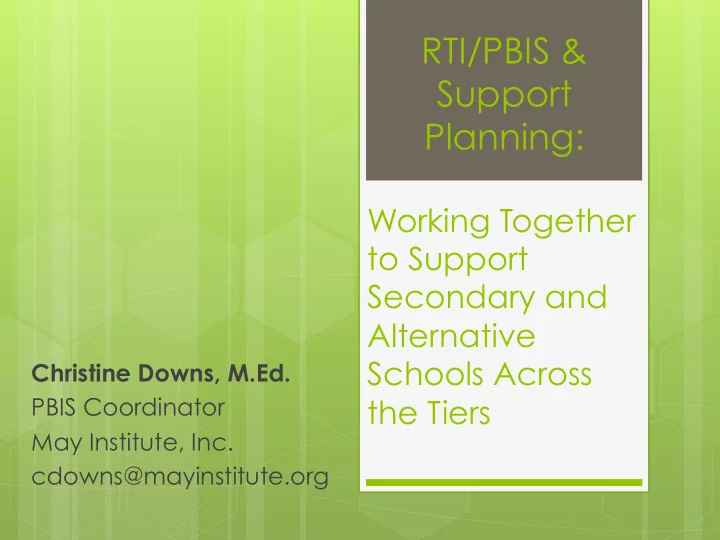

RTI/PBIS & Support Planning: Working Together to Support Secondary and Alternative Schools Across Christine Downs, M.Ed. PBIS Coordinator the Tiers May Institute, Inc. cdowns@mayinstitute.org
Acknowledgments Jessica Swain-Bradway, Ph.D. Midwest PBIS Center Institute on Community Integration University of Minnesota Kimberli Breen Illinois ISTAC Polly Neumann-Anderson Wrap Facilitator Madison, WI Pat Wolfe, Ed.D. Mind Matters, Inc
Outcomes 1. Better understanding of adolescent brains 2. Learning strategies for adolescents 3. Why students drop out 4. Strategies for graduation 5. Support Teams 6. Layering Interventions
Who’s in the room? What level do you work with? High Schools Middle Schools Alternative Schools Who has been trained in PBIS? Who has been trained in RTI?
PAIR and Share Common issues for secondary students
Common issues for secondary students 1. Not prepared /unfocused/ disengaged 2. Conflicts with adults/ teachers/ authority 3. Risk taking/thrill seeking 4. Emotional/socially focused/little empathy 5. Overly Stressed and anxious or checked out
Brain Development Prefrontal Cortex- You’ve got one and you use it! Responsibility, organization, prioritization center Not fully developed until about age 25 Amygdala- Kicking it Teen Style! Between 12-25 years old (approximate) brain is undergoing massive restructuring Infant / Toddler: massive “fixing” of neurological pathways Adolescence: realignment of pathways, white matter development (myelination), amygdala over compensating.
How the brain works Prefrontal Cortex Amygdala Organization of multiple tasks Emotional responses Impulse inhibition Response to/need for Self control pleasure/reward Setting goals and priorities (heightened in Empathizing with others Initiating appropriate adolescents) behavior Response to fear Making sound judgments Forming Strategies Motivation Planning ahead Impulsive thinking (risk Adjusting behavior when taking/reactionary) situation changes Stopping an activity upon completion Insight
Learning Strategies for the Developing Adolescent Brain Don’t overload with complicated directions or multitasking The addition of emotion can help students remember The brain is social and requires interaction to develop properly Practice/rehearsal is critical to learning and retention Teens taken in more information visually than any other sense.
Why students drop out Most empirically robust predictor of drop out is academic failure (Allensworth & Easton, 2005; Berktold, Geis, & Kaufman, 1998; Harlow, 2003; Jordan McPartland, & Lara, 1999; Kemple, Herlihy & Smith, 2005; Markow & Scheer, 2002). Students who drop out are NOT connected to school (Berktold, Geis, & Kaufman, 1998; Harlow, 2003 : Jerald, 2006; Bridgeland, DiIulio, & Morison, 2006). 24% of students who drop out are unable to identify an adult in the school by whom they feel supported (2006 High School Survey of Student Engagement).
Problem behavior Academic failure (e.g. disruption, (Allensworth & Easton, disrespect, etc.) 2005; Balfanz, & Herzog, (Sweeten, 2006; Tobin & 2005), Sugai, 1999 Poor teacher History of grade relationships (Barber retention (Allensworth & Olson, 1997) et al, 2005), Diagnosed with a Low attendance disability (NTLS-2, ; (Balfanz, & Herzog, 2005; Wagner, Newman, Jerald, 2006; Neild & Cameto, Levine, Garza, Balfanz, 2006) 2006).
What Drop Out Costs $10,000 less in average yearly income for students who drop out of school (HHS, 2006). Each student who drops out costs the federal government $260,000 over course of lifetime (Rouse, 2005). A 5% increase in graduation rates of male students alone would equate to savings of $8 billion in crime related costs (Alliance for Excellent Education, 2006).
Schools are not structured for adolescent success Inconsistent Environment (expectations/ block schedules) Lots of multitasking Classes very didactic / passive Lots of independent work Support withheld until problems are serious
Supporting Graduation ABCs Attendance Behavior Completion of Work Multi-pronged approach beginning with universal climate of support Target vulnerable groups Intensity match
Supportive Climates High Expectations + High Supports Frequent, positive adult interactions (Christenson, Lehr, & Anderson, 2003) Home school connection (Sinclair, Christenson, Lehr, & Anderson, 2003) Predictable, structured day /activities (Lee and Burkham, 2003) Social and Academic supports (Kemple, Herlihy, & Smith, 2005). Fewer “basic” level classes More advanced classes, with adequate support (Jerald, 2006)
Student PBIS CST Support IST Team Behaviora l Support Academic FBA/BIP Support RTI Individual Grade Support Level 504/IEP
Team Audit Workgroup/ Outcome/ Who do Names of Non- How do we Overlap? Link to SIP we Staff negotiable measure Committee/ Modify? serve? impact? District Team Mandate? Attendance Improve students Junebug, Leo, yes Attendance Yes-fold to SW Committee school Tom records PBS attendance SW PBS Team Teach Students Ben, Tom, Lou no ODR, Attend, Yes- continue expectations MIR,Nursing staff provide log ,climate support Safety Improve Students Toni, Barb,Tom no Office Yes-fold into SW Committee school safety PBS staff Referrals BIG 5, climate School Spirit Encourage students Tom no No Yes-fold into SW Committee school PBS community Discipline Improve students Tom, Lou no Office Yes-fold into SW Committee discipline pbs Referrals Student Support Support students Steve, yes Discipline, No- continue Team/Problem students not Sue,Jon, DIBELS, Solving Team responding Tom FACTS … School Improve our 1,2,3 Bill, Jon, Lou, yes All of the Yes- continue Improvement school Tom above academic &behaviorally
School-Wide Systems for Student Success: A Response to Intervention (RtI) Model Academic Systems Behavioral Systems 1-5% Tier 3/Tertiary Interventions Tier 3/Tertiary Interventions 1-5% • Individual students • Individual students • Assessment-based • Assessment-based • Intense, durable procedures • High intensity Tier 2/Secondary Interventions 5-15% 5-15% Tier 2/Secondary Interventions • Some students (at-risk) • Some students (at-risk) • High efficiency • High efficiency • Rapid response • Rapid response • Small group interventions • Small group interventions • Some individualizing • Some individualizing Tier 1/Universal Interventions 80-90% 80-90% Tier 1/Universal Interventions • All students • All settings, all students • Preventive, proactive • Preventive, proactive Illinois PBIS Network, Revised May 15, 2008. Adapted from “ What is school-wide PBS? ” OSEP Technical Assistance Center on Positive Behavioral Interventions and Supports. Accessed at http://pbis.org/schoolwide.htm
IMPLEMENTATION W/ FIDELITY UNIVERSAL CONTINUUM OF SCREENING EVIDENCE-BASED RtI INTERVENTIONS DATA-BASED PREVENTION DECISION & EARLY MAKING & INTERVENTION PROBLEM CONTINUOUS SOLVING PROGRESS MONITORING
Recommend
More recommend